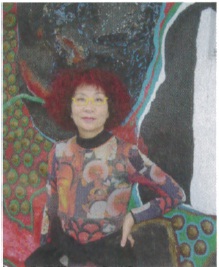Kunie Usuki — Fostering creativity without borders
by Kirk R. Patterson
Kunie Usuki, a native of Hiroshima Prefecture, is the creative force behind Design Festa, which provides opportunities for aspiring artists to showcase their talents. Kunie and her team organize a twice-a-year art exhibition at Tokyo Big Sight and rent out gallery space in Harajuku.
How did you establish a career in the art world?
I was born in Onomichi City, Hiroshima Prefecture and grew up as a real ‘ocean girl’ playing along the shores of the Seto Inland Sea. When I was in grade six of elementary school, an oil painting that I did was selected to be displayed in the Tokyo Metropolitan Art Museum, and so I took the overnight train to Tokyo to collect a special prize.
I studied art all through junior and senior high school, and at the age of 18 I came to Tokyo to study art at Atomi College. By that time, however, I was bored with art and so my attention turned to the world of rock n’ roll. After graduating, I remained in Tokyo just to stay in the music world. To make ends meet, though, I did a variety of jobs such as working as a movie set designer and as an interior designer. Also around this time, I married (at 23) but later got divorced.
After managing a model agency for two years, I become a freelance ‘stylist’. That got me involved in all aspects of producing TV commercials, doing everything from selecting actors’ wardrobes to choosing filming locations. It was a very exciting job, but at the same time I wasn’t totally satisfied. I was still looking for something else.
When the economic bubble burst in the early 1990s, the work dried up and so I was forced to reconsider what I wanted to do with my life.
Is that when you started Design Festa?
Not quite. At first, I was introduced to some people who wanted to hold an event for fashion designers, who often find that they spend too much time trying to find customers rather than doing actual design work. They rented an event space in Harumi and started looking for fashion designers to rent booths to display their work, but they couldn’t find enough designers to join the project. So I ended up taking over the project, which was opened up to become the first event to welcome anybody who wanted to rent a booth to showcase their artistic or creative talents.
When was that and how did you manage to get it started?
The first Design Festa was in September 1994. Working with just one assistant, I made flyers and went all over Japan, asking that they be displayed at design schools, shops, and elsewhere. We ended up renting out 830 booths. That was the beginning of Design Festa. We now run Design Festa twice a year. At the November event, we had about 2,600 booths and attracted over 50,000 people.
What makes Design Festa so successful?
Most importantly, there is no screening or judging process to determine who can participate. Anybody is welcome, regardless of their experience and talents. Because one person’s ‘bad art’ may be considered great by somebody else, we do not limit the variety of work on display.
Another key is that sponsors are not allowed. Also, it is open to individuals horn all over the world (we had participants from over 35 countries in November) and all ages (in November, the age range was three to 93).
Tell me about your Design Festa Gallery.
We rent almost all of a former apartment building, with each of the apartments converted to gallery space that artists can rent for as short as just three days. Some of the galleries even have facilities enabling the artists to live in them while producing their work, which makes them especially popular for artists from overseas. We also sponsor parties and other events that bring together artists from Japan and around the world. Artists can find out more about our rental galleries and events by going to our website, www.designfesta.com.
What are your plans for the future?
We want to create a Design Festa Village in Harajuku, with the next step being to rent a nearby building to house a multimedia mini-theater. Also, in 2007 we plan to take the Design Festa exhibition to New York City, where artists from Japan, U.S.A. and other countries will be able to exhibit together, thereby furthering contributions to an artistic world that spans national borders.









